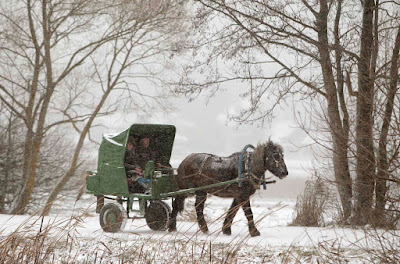Since it’s December 21 tomorrow, the winter solstice, I thought it would be most appropriate to write a short essay on a winter solstice poem by Robert Frost. Many people are familiar with his “Stopping by Woods on a Snowy Evening,” especially familiar with that closing quatrain, with the last lines about having promises to keep, and miles to go before “I sleep.” It’s such an innocent little poem, almost like a verbal Christmas card, with such innocently simple words tying it all up with a neat little Christmas bow. The speaker (Frost? A country doctor? A farmer?) is on his way by horse and carriage to some unnamed destination (His home? The village?). It’s late at night (“the darkest evening of the year,” thus, probably the longest night of the year, December 21st), with soft New England snow falling, no one around, almost perfectly silent. He stops along the way to contemplate the snow and the nearby woods. He looks, considers the beauty of the scene, then continues on his way. It’s all so simple that you’d think anyone could have written it, even a child. Here it is.
Whose woods these are I think I know.
His house is in the village, though;
He will not see me stopping here
To watch his woods fill up with snow.
My little horse must think it queer
To stop without a farmhouse near
Between the woods and frozen lake
The darkest evening of the year.
He gives his harness bells a shake
To ask if there is some mistake.
The only other sound’s the sweep
Of easy wind and downy flake.
The woods are lovely, dark, and deep,
But I have promises to keep,
And miles to go before I sleep,
And miles to go before I sleep.
See? Just a simple little picture painted in simple language in a simple poetic form. First, let’s look at this simple form: four quatrains (four-line stanzas) in iambic tetrameter (four feet of alternating unaccented/accented rhythm; a rhyme pattern that is a-a-b-a in the first stanza, followed by b-b-c-b in the second stanza, hooking the second to the first by using the rhyme in the third line of the first stanza as the predominant rhyme in the second; then doing the same for the third and fourth stanzas. This pattern is called interlocking rubaiyat (although a strict conformity to this would have five feet instead of four). Simple, right? The poet could go on and on, hooking together each stanza with the preceding in a poetic daisy-chain. Frost chose to use only four stanzas. But how to get out of the interlock? In his case, he simply repeats the last line, giving him a final stanza of d-d-d-d. Not such a simple form after all, is it? Now, about that simple little Christmas card picture. Critics have almost universally pointed to that lovely, dark, deep woods as a Frostian death wish. He’d love to go into those woods but life’s obligations keep him from doing so, and he has years (“miles”) left to live before he can die (“sleep”). Or maybe the critics have all read too much into it, and it really is simply a little innocent Christmas card and not an ominous death wish. What do you think? Oh, yes, and happy winter solstice tomorrow.

I've always collected errors in diction, things people mis-hear, like "windshield factor" and "the next store neighbors." Years ago, one of my students wrote an essay in which she described the world as being harsh and cruel, "a doggy-dog world." I've since come to think she may have been more astute and accurate than those who describe it in the usual way. My Stories - Mobridge Memories -
About Me
Translate
Most of what I've written has been published as e-books and is available at Amazon. Match Play is a golf/suspense novel. Dust of Autumn is a bloody one set in upstate New York. Prairie View is set in South Dakota, with a final scene atop Rattlesnake Butte. Life in the Arbor is a children's book about Rollie Rabbit and his friends (on about a fourth grade level). The Black Widow involves an elaborate extortion scheme. Happy Valley is set in a retirement community. Doggy-Dog World is my memoir. And ES3 is a description of my method for examining English sentence structure.
In case anyone is interested in any of my past posts, an archive list can be found at the bottom of this page. I'd appreciate any feedback you may have by sending me an e-mail note--jertrav33@aol.com. Thanks for your interest.


No comments:
Post a Comment